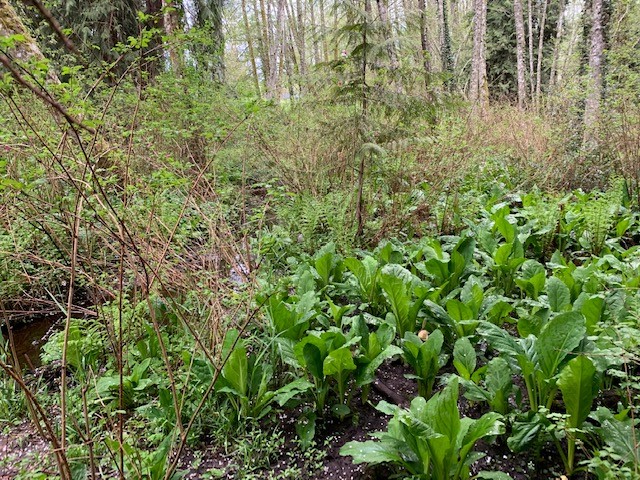Wetlands: Nature's water filters, sponges & nurseries
Skunk cabbage, a wetland indicator plant, emerges in the spring along a trail in a city park in Olympia.
Wetlands are critical to the overall health of watersheds. We protect, restore, and manage the state's remaining wetland resources because of their key role in watershed health.
What are wetlands?
Wetlands — commonly called marshes, swamps, or bogs — are land areas that are saturated or covered with water for at least some part of the year. A wetland can be the edge of a river or a lake, a shallow pond or swamp, a marshy field or forested bog, or a shrubby area filled with willows. Despite the variety of wetlands, they have three characteristics in common:
- Hydric soils: Soils that are saturated long enough to produce anaerobic conditions.
- Water-tolerant plants: Hydrophytic plants can tolerate anerobic conditions of hydric soils.
- Water: Present at or near the land surface periodically or continuously during the growing season.
For regulatory purposes, wetlands are defined in several state laws and rules: The Shoreline Management Act (Chapter 90.58.030 RCW), Washington’s Water Quality Standards (Chapter 173- 201A-020 WAC), and the Growth Management Act (Chapter 36.70A.030 RCW).
Wetland functions that are important to people
- Carbon cycling
- Erosion control
- Flood control
- Groundwater recharge
- Recreation
- Research and education
- Regional economic vitality
- Water filtration and purification
- Wildlife habitat
The functions performed by an individual wetland depend on its location, surrounding topography, subsurface geology, amount and duration of water, and the types of plants present. While each wetland may not perform all functions, the cumulative value of all wetlands in a watershed makes each important.
Our role protecting, restoring, and managing wetlands
The state's Water Pollution Control Act and the Shoreline Management Act gives us the authority to regulate wetlands. We also use the State Environmental Policy Act (SEPA) process to identify potential wetland-related concerns early in the permitting process. Our wetland staff review applications for projects that have the potential to affect wetlands and other state waters.
We provide technical assistance to local governments under the Growth Management Act. This includes assistance in developing comprehensive plan policies and development regulations and implementing local wetland regulations.
Beyond regulation
Regulations are only one tool to protect wetlands. There are many nonregulatory opportunities to conserve wetland resources. Comprehensive wetlands protection includes voluntary wetland stewardship actions taken by landowners and local communities. These actively preserve, restore, and enhance existing wetlands.
We also work in partnership with local and tribal governments, land trusts, and other state and federal agencies to acquire, restore, and enhance wetlands through the National Coastal Wetlands Conservation Grant Program.
Local governments, consultants, developers, and landowners can find wetland resources and guidance documents by using the related links below. If you have a specific question, contact our wetland staff.

